Comments
- No comments found

Overall US life expectancy is rising, but US suicide rates are also rising.
The Centers for Disease Control and Prevention have recently published some short ”Data Briefs” showing the patterns. In terms of age groups, suicide rates are up for all age groups except for those over 75 years of age. By ethnicity, the increases in suicide rates are largely explained by a rise in suicides in the white population. In terms of methods of suicide, the share of suicides by firearms is falling, while the share by suffocation is rising.
I won’t offer any instant-insight analysis here about deeper meanings and policy implications. My heart just goes out to those who have committed suicide, and to everyone who has lost a dear one to suicide. But here are some figures to illustrate the patterns. Sally C. Curtin, Margaret Warner, and Holly Hedegaard wrote ”Increase in Suicide in the United States, 1999–2014". The overall trend of suicides (adjusted for shifts in the age of the population) looks like this;
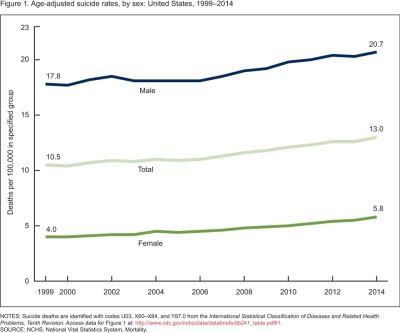
The breakdown by age group shows that suicide rates have risen among all under-75 age groups, but the highest suicide rates are in the 45-64 age bracket, and that\’s also where the biggest increases in the suicide rates have occurred. The first figure shows the rates for females; the second for males.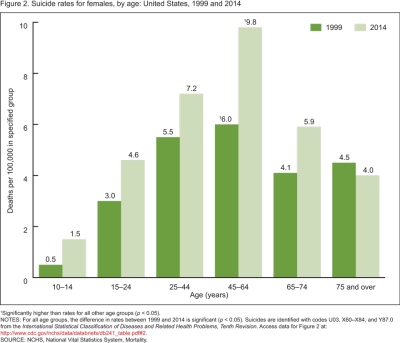
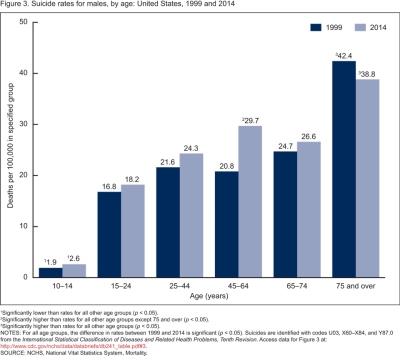
The same three authors also wrote ”Suicide Rates for Females and Males by Race and Ethnicity: United States, 1999 and 2014.” The abbreviation API refers to Asian or Pacific Islanders, and the abbreviation AIAN refers to American Indian or Alaska Native. Of course, a much larger share of the US population is white than in the American Indian/Alaska Native category, so the rise in the suicide rate among whites is the primary driver of the rise in the overall suicide rate. The first figure shows suicide rates for females, and the second for males.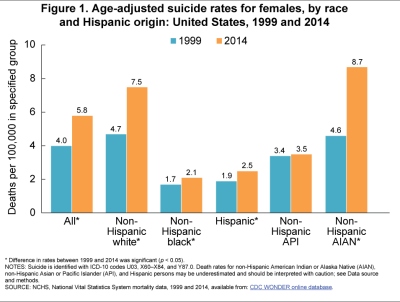
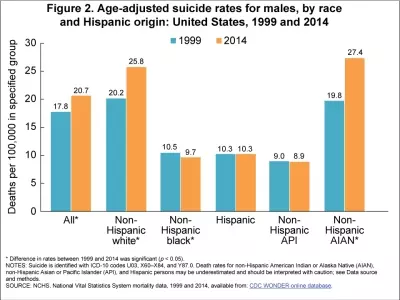
Finally, the share of suicides in which a firearm was used remains large, but has declined over time, while the share of suicides involving suffocation has risen. 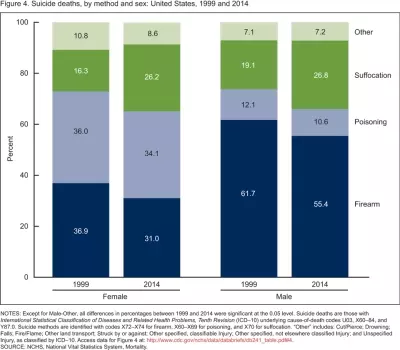
Timothy Taylor is an American economist. He is managing editor of the Journal of Economic Perspectives, a quarterly academic journal produced at Macalester College and published by the American Economic Association. Taylor received his Bachelor of Arts degree from Haverford College and a master's degree in economics from Stanford University. At Stanford, he was winner of the award for excellent teaching in a large class (more than 30 students) given by the Associated Students of Stanford University. At Minnesota, he was named a Distinguished Lecturer by the Department of Economics and voted Teacher of the Year by the master's degree students at the Hubert H. Humphrey Institute of Public Affairs. Taylor has been a guest speaker for groups of teachers of high school economics, visiting diplomats from eastern Europe, talk-radio shows, and community groups. From 1989 to 1997, Professor Taylor wrote an economics opinion column for the San Jose Mercury-News. He has published multiple lectures on economics through The Teaching Company. With Rudolph Penner and Isabel Sawhill, he is co-author of Updating America's Social Contract (2000), whose first chapter provided an early radical centrist perspective, "An Agenda for the Radical Middle". Taylor is also the author of The Instant Economist: Everything You Need to Know About How the Economy Works, published by the Penguin Group in 2012. The fourth edition of Taylor's Principles of Economics textbook was published by Textbook Media in 2017.
Leave your comments
Post comment as a guest